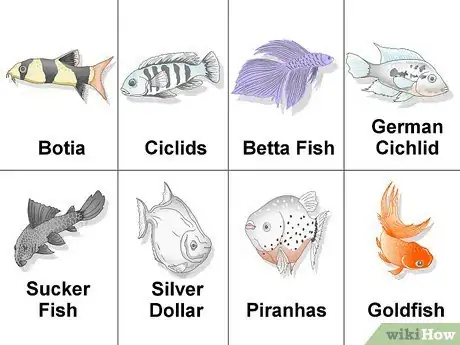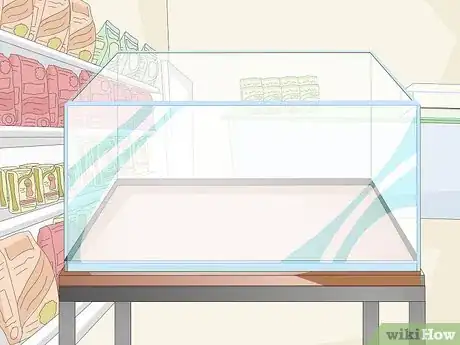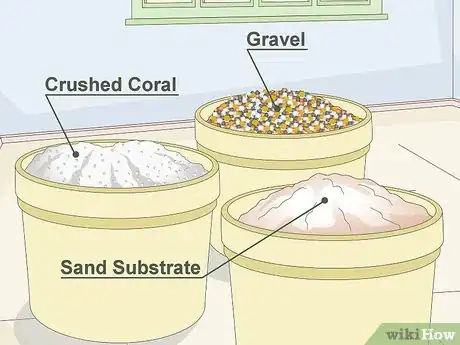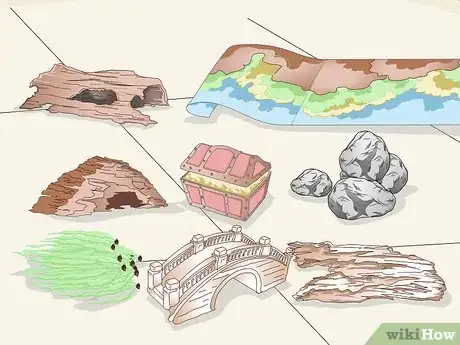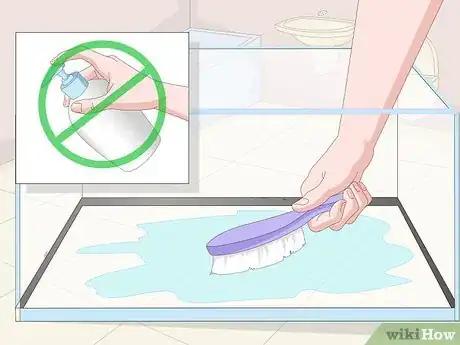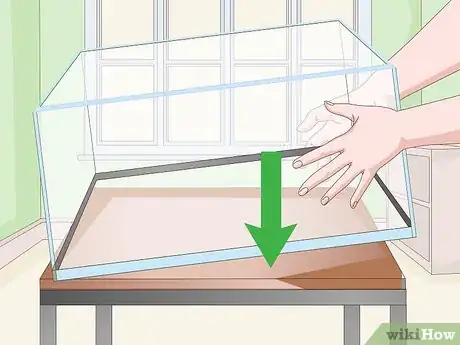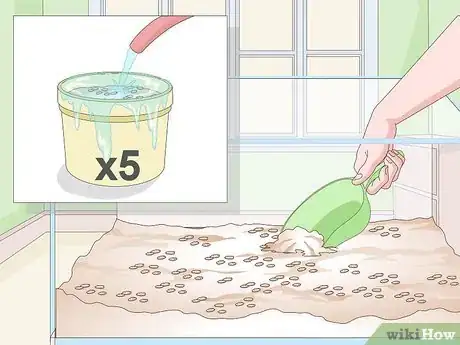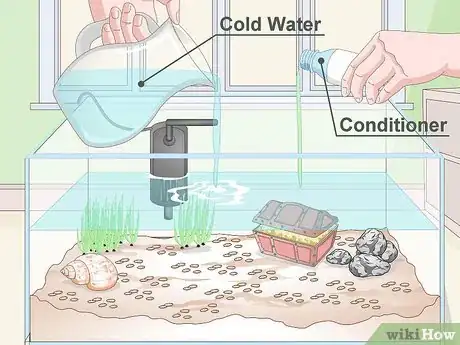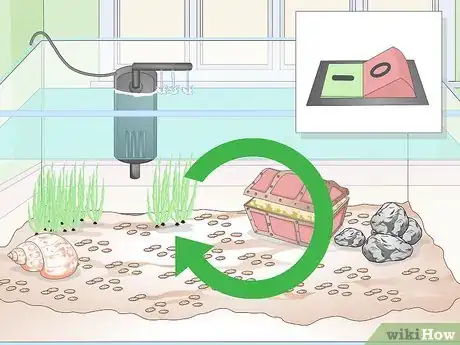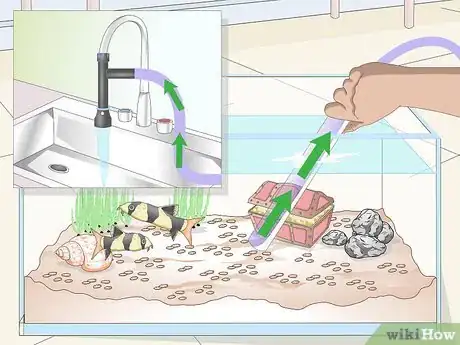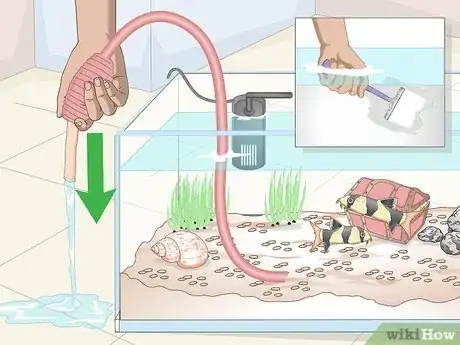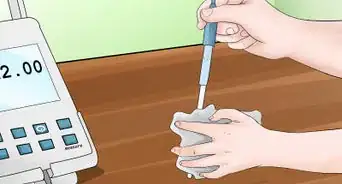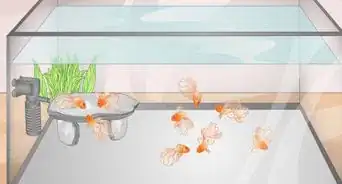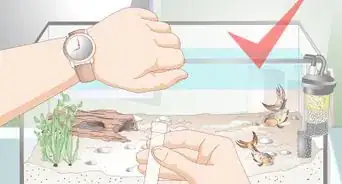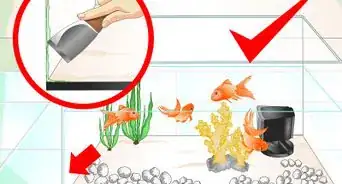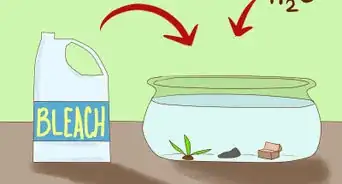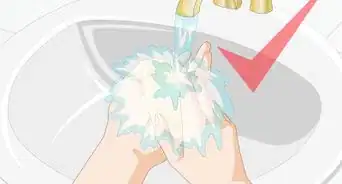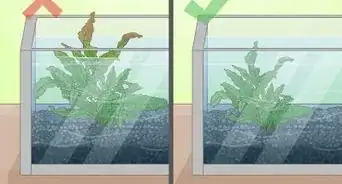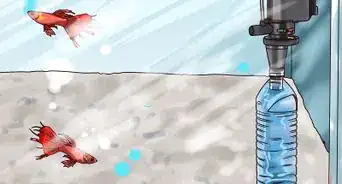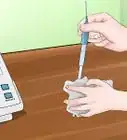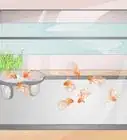This article was co-authored by Doug Ludemann. Doug Ludemann is the owner and operator of Fish Geeks, LLC, an aquarium services company based in Minneapolis, Minnesota. Doug has worked in the aquarium and fish-care industry for over 20 years, including having worked as a professional aquarist for the Minnesota Zoo and Shedd Aquarium in Chicago. He received his Bachelor of Science in Ecology, Evolution, and Behavior from the University of Minnesota.
There are 8 references cited in this article, which can be found at the bottom of the page.
This article has been viewed 110,611 times.
Setting up a coldwater aquarium requires a lot of planning. In order to purchase the appropriate tank and materials, you will first need to determine what kinds of fish, as well as how many fish, will be in the tank.[1] When setting up your tank, place it on a sturdy surface and away from heat sources and direct sunlight to ensure that it stays cool. Clean the materials that will go inside the tank with warm water before arranging them in it. Then, install a high-quality filtration system before filling the tank with water, and let the system run for at least one to two weeks before putting your fish in the tank.
Steps
Getting the Essentials
-
1Determine what kind of fish you want. Goldfish, Rosy Barbs, and Guppies are excellent starter fishes. Before you buy your tank and other supplies, determine what kinds of fish and how many fish you will have in the tank. This way, you can buy an appropriate sized tank and the appropriate gravel or substrate.[2]
-
2Buy a tank. It is recommended that you buy a large tank instead of a small tank. Larger tanks are easier to clean, and you can add more fish to larger tanks. Avoid common myths that tell you it is acceptable to keep fish in bowls. Larger tanks also allow your fish to grow while still being comfortable. Keeping fish in an overcrowded tank is the fastest way to reduce water quality and introduce toxins and diseases to the water.[3]
- It is recommended that you start with a fish tank that can hold between 20 and 55 gallons. For smaller fish, use a tank that can hold around 10 gallons.
- It is also better to buy a wide tank instead of a tall tank. Wide tanks have more surface area, and thus, allow more oxygen to enter the water and more waste gasses to escape.
Advertisement -
3Select the appropriate gravel. Gravel, or substrate, comes in various sizes, colors, and forms. You can choose from gravel, sand, or crushed coral. Gravel is the most common form of substrate and comes in small to large sizes. It is recommended that you buy gravel that is medium in size.[4]
- Do not buy gravel with sharp edges. The sharp edges can harm the fish's scales. Fish that like to pick up the gravel or dig into the gravel are especially at risk.
- Sand substrate is great for fish with delicate barbells, such as the Corydoras catfish. However, it is very difficult to clean and can get stuck in your filter. If you have a picky eater, like a puffer fish, it might swallow the substrate.
- Crushed coral gravel is great for fish that prefer a higher pH, such as African cichlids, as this reflects on their natural habitat.
-
4Choose a high-quality filter.[5] There are three different types of filtration systems: external, internal, and under gravel. However, whichever you choose, make sure it is high-quality. Internal filters are great for small tanks.[6]
- Under gravel filters move the water through the gravel, which induces biological filtration to occur. They pull water in and they release it out of the spout.
- Examples of high-quality filters are the Fluval External filter, Penn Plax Cascade canister, and the EHEIM Classic External canister.
-
5Pick your decorations. There are a variety of decorations you can choose from. There are aquarium backdrops, rocks, driftwood, plants (both real and fake), and furniture or decoration caves, tunnels, and bridges. Make sure to purchase a variety of decorations. A starter kit tank though comes with a rather childish decor, as it is marketed toward children.[7]
- Plants and furniture allow your fish to hide out, feel safe, and relieve stress. However, for more greedy, herbivorous fish, make sure to get more sturdy, nip-proof plants.[8]
- Aquarium backdrops are great for hiding cables and equipment behind the tank. They also create an illusion of depth for the fish.
- Make sure the decorations you buy are safe and non-toxic sharp objects are harmful to fish, especially to the Eye goldfish and the Black Moor fish.
Setting Up the Tank
-
1Clean the tank once a week. The tank and other materials (gravel and decorations) that will be placed in the tank need to be cleaned with warm tap water. Do not use soap or detergent to clean the tank and other materials. The residue left by soap or detergent is toxic to fish.[9]
-
2Place your tank on a sturdy surface. One gallon of water weighs 10 pounds, and the average tank size is 30 gallons. Therefore, the object that you'll place your tank on needs to be very sturdy. Place your tank on a sturdy wooden cabinet or table, as the tank might fall down, which would kill the fish and make a mess on your carpet.[10]
- If you do not have a sturdy cabinet or table, use a cabinet or stand that is designed for holding fish tanks, especially big ones.
- Make sure to place your tank in a cool area, away from heat and out of direct sunlight to avoid overheating the tank, because overheating might boil the water, and this will burn the fish to death.
-
3Add the gravel. Before placing the gravel, also known as substrate, into the tank, clean it first. Run tap water through the gravel about five times until the water runs clear. Place the gravel on the bottom of the tank until it is about two to three inches high. Spread the gravel evenly in the tank.[11]
-
4Arrange the decorations. If you bought an aquarium wallpaper or backdrop, attach it to the back of your tank first. Then, begin arranging your decorations as you like. Put the larger decorations near the back of the tank and smaller ones near the front of the tank.[12]
-
5Install the filtering system. Most filters require assemblage before placing them into the tank. Assemble your filter according to the manual provided by the manufacturer. For most filters, you just need to assemble a few parts. Do not turn the filter on until the tank is filled with water.[13]
- For gravel filters, you will need to place the filter underneath the gravel. Make sure it is stable under the gravel. Attach the pump airlines and power head to the appropriate lift tubes before turning the filter on.
- For an internal and external filter, mount it onto one of the tank’s walls, preferably onto the wall that is closest to an outlet. These filters have an external power cable that connects to the main power for filtration to begin. Make sure the power cable will not come into contact with the tank’s water.
-
6Fill the tank. Begin filling the tank with cold water. Slowly add the water to the tank with a pitcher or a hose so as not to disrupt or displace the gravel. Most tanks have a water line indicating where you should fill it to. Once the tank is filled, add the water conditioner or de-chlorinator and stress coat to the water per the instruction manual.[14]
- The water conditioner and stress coat make tap water safe for your fish to live in.
- Place a bowl on the gravel when filling the tank with water to prevent the gravel from moving and dispersing.
-
7Let the filter run. Once everything is set up, turn on the filter. Let the filter run for at least a week before placing your fish in the water. Letting your tank run or cycle allows beneficial bacteria to build up. These bacteria help keep the tank’s water stable for the fish to live in.[15]
- The longer you let the tank filter the safer the water will be for the fish.
- Add the sturdiest and strongest fish first, like the starter fish, before adding in more fish.
Cleaning the Tank
-
1Purchase the cleaning materials. In order to the clean the tank you will need a net to safely remove the fish, a vacuum or siphon to remove the debris, and a five gallon bucket to change the water.[16]
- You do not need to remove the fish from the water each time you clean the tank. It is best if you can try to keep the fish inside the water while you clean it. If you need to remove the fish, then use the net to transfer them to a large container. Make sure the water is de-chlorinated before placing the fish in the temporary container.
-
2Vacuum the tank. You will need to vacuum or siphon feces and debris from the tank at least once a week. Use a siphon to remove the debris. If you have gravel in your tank, run the vacuum over the top of the gravel. If you have sand, hold the vacuum slightly above the sand to avoid dispersing and/or sucking up the sand.[17]
-
3Change the water.[18] You will also need to change the water once a week. Use a five-gallon pitcher to remove and replace the water. Replace a third of the water with fresh water each week.[19]
- If algae is growing on the tank’s walls, then clean and remove this, as well. Use a clean rag to remove the algae. If the fish is attempting to get past your hand and nip the rag you can use an algae scrubber, which you can buy online or at your local pet store (Or Fish Market.)
Expert Q&A
Did you know you can get expert answers for this article?
Unlock expert answers by supporting wikiHow
-
QuestionWhy is regulating the temperature of my aquarium important?
 Doug LudemannDoug Ludemann is the owner and operator of Fish Geeks, LLC, an aquarium services company based in Minneapolis, Minnesota. Doug has worked in the aquarium and fish-care industry for over 20 years, including having worked as a professional aquarist for the Minnesota Zoo and Shedd Aquarium in Chicago. He received his Bachelor of Science in Ecology, Evolution, and Behavior from the University of Minnesota.
Doug LudemannDoug Ludemann is the owner and operator of Fish Geeks, LLC, an aquarium services company based in Minneapolis, Minnesota. Doug has worked in the aquarium and fish-care industry for over 20 years, including having worked as a professional aquarist for the Minnesota Zoo and Shedd Aquarium in Chicago. He received his Bachelor of Science in Ecology, Evolution, and Behavior from the University of Minnesota.
Professional Aquarist
-
QuestionDo coldwater fish need artificial light?
 Dieyun DingTop AnswererYes. Since it's not recommended to put an aquarium in direct sunlight, you should have lights that you can control to give your fish around 10 hours of light per day. Turn the lights on in the morning, and off at night. This will give your fish a less stressful and more natural environment.
Dieyun DingTop AnswererYes. Since it's not recommended to put an aquarium in direct sunlight, you should have lights that you can control to give your fish around 10 hours of light per day. Turn the lights on in the morning, and off at night. This will give your fish a less stressful and more natural environment. -
QuestionWill I need a live plant?
 Benjamin Y. JacksonCommunity AnswerAdding plants to an aquarium adds to the biodiversity of a system. It would be a good thing to add one, but be careful what you add. A little research will prove rewarding as to what one will enjoy adding.
Benjamin Y. JacksonCommunity AnswerAdding plants to an aquarium adds to the biodiversity of a system. It would be a good thing to add one, but be careful what you add. A little research will prove rewarding as to what one will enjoy adding.
References
- ↑ Doug Ludemann. Aquarium Care Professional. Expert Interview. 27 August 2019.
- ↑ http://www.pets4homes.co.uk/pet-advice/information-about-fish-for-potential-fish-owners.html
- ↑ http://goldfish2care4.com/fish-tank-set-up.html
- ↑ http://www.ratemyfishtank.com/blog/choosing-a-freshwater-aquarium-substrate
- ↑ Doug Ludemann. Aquarium Care Professional. Expert Interview. 27 August 2019.
- ↑ http://aquariumadviser.com/#Best_Fish_Tank_Filters_for_the_Money
- ↑ http://goldfish2care4.com/fish-tank-set-up.html
- ↑ Doug Ludemann. Aquarium Care Professional. Expert Interview. 27 August 2019.
- ↑ http://www.allaquariuminfo.com/2011/11/how-to-set-up-coldwater-goldfish-fish.html
- ↑ http://www.allaquariuminfo.com/2011/11/how-to-set-up-coldwater-goldfish-fish.html
- ↑ http://goldfish2care4.com/fish-tank-set-up.html
- ↑ http://www.petworlddirect.ie/z/how-to-set-up-a-cold-water-aquarium/276
- ↑ http://aquariumadviser.com/how-to-install-a-fish-tank-filter/
- ↑ http://www.petworlddirect.ie/z/how-to-set-up-a-cold-water-aquarium/276
- ↑ http://www.petworlddirect.ie/z/how-to-set-up-a-cold-water-aquarium/276
- ↑ http://www.pets4homes.co.uk/pet-advice/information-about-fish-for-potential-fish-owners.html
- ↑ http://www.pets4homes.co.uk/pet-advice/information-about-fish-for-potential-fish-owners.html
- ↑ Doug Ludemann. Aquarium Care Professional. Expert Interview. 27 August 2019.
- ↑ http://www.pets4homes.co.uk/pet-advice/information-about-fish-for-potential-fish-owners.html
About This Article
To set up a coldwater aquarium, purchase a 20 to 55-gallon tank for larger fish, or a 10-gallon tank for smaller fish. Then, research which gravel to buy for your fish. For example, crushed coral gravel works great for fish that prefer a higher pH, like the African cichlid, but sand substrate is better for fish with delicate barbells, like the Corydoras catfish. Once you've found the right gravel, rinse it clean with tap water, then add it to the tank. Before you add water, decorate the tank with driftwood, plants, rocks, and other hiding places for your fish. When you're ready, slowly fill the tank with cold water, pour in the water conditioner or de-chlorinator, and let the filter run for a week before adding in fish. For more tips, like how to clean a coldwater aquarium, scroll down!

